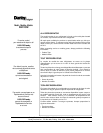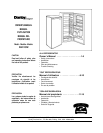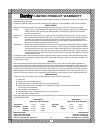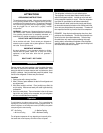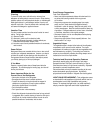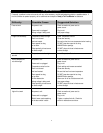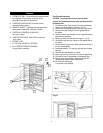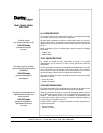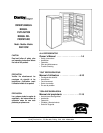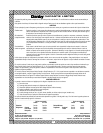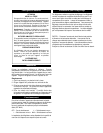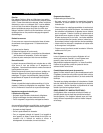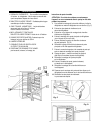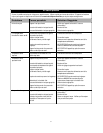
Cleaning
To clean the inside, use a soft cloth and a mixture of one
tablespoon of baking soda to one quart of water. Other cleaning
solutions options are a mild soap suds solution, or mild detergent.
Wash glass shelves in a mild detergent solution, then dry and
wipe with a soft cloth. Clean the outside with a soft damp cloth
and some mild detergent or appliance cleaner.
Vacation Time
For short vacation periods, leave the control knob at its normal
setting. During longer absences;
(a) remove all foods,
(b) disconnect power cord from electrical outlet
(c) clean the refrigerator thoroughly, including defrost pan,
located above compressor at back of unit.
(d) leave door open to avoid possible formations of condensate,
mold or odors.
Power Failure
Most power failures are corrected within an hour or two and will
not affect your refrigerator temperatures. However, you should
minimize the number of door openings while the power is off.
During power failures of longer duration, take steps to protect
your food by placing dry ice on top of packages.
If You Move
Remove or securely fasten down all loose items inside the
refrigerator. To avoid damaging the leveling legs, turn them all
the way into the base.
Some Important Rules for the
Correct Use of the Refrigerator
• Never place hot foods in the refrigerator.
• Beverages should be stored in sealed containers.
• Foods to be stored for a long time should be wrapped in
cellophane or polyethylene, or kept in glass containers.
Never place spoiled foods in the cabinet.
• Don’t overload the cabinet.
• Don’t open the door unless necessary.
• Should the refrigerator be stored without use for long periods it
is suggested, after a careful cleaning, to leave the door ajar to
allow the air to circulate inside the cabinet in order to avoid
possible formations of condensate, mold or odors.
Food Storage Suggestions
Fresh Food Compartment
• Never cover food compartment shelves with aluminum foil or
any other shelf covering material which may prevent
air circulation.
• Always remove porous store wrapping paper from meats,
poultry and fish. Meats should be wrapped individually
and placed in a dish for storage. Wrap fish and poultry in foil
or heavy waxed paper. Most fish should be used the same day
of purchase. Packaged meats such as ham, bacon, dried beef,
or frankfurter, store best in their original packages.
• Allow warm foods to cool to room temperature before placing
them in the refrigerator.
• Always cover open dishes of food, especially leftovers. Use
leftovers within 2 or 3 days.
Vegetable Crisper
The vegetable crisper is located at the bottom of the refrigerator
compartment and is covered to retain moisture. The crisper
compartment will enable you to store fruits and vegetables which
would otherwise dry out rapidly. The humidity level inside the
crisper can be controlled by adjusting the sliding damper control
located at the front of the crisper drawer.
Technical and Structural Operation Features
Hermetically sealed cooling unit with midget 2 pole motor.
Rustproof anodized "Roll-Bond" aluminum freezer (or Pipe on
Sheet aluminum freezer) of high thermal conductivity. Adjustable
thermostat for automatic temperature control.
Cabinet bondrized and acrylic-enameled according to the most
modern electrostatic spraying techniques. High-density
polyurethane theramal insulation. Magnetic door closure gasket.
LIGHT BULB REPLACEMENT: This refrigerator uses
a standard 40 watt appliance light bulb which can be
purchased at most local hardware and grocery
stores. To replace the light bulb, (no tools required)
simply unscrew light bulb and install replacement.
3
Care and Maintenance



